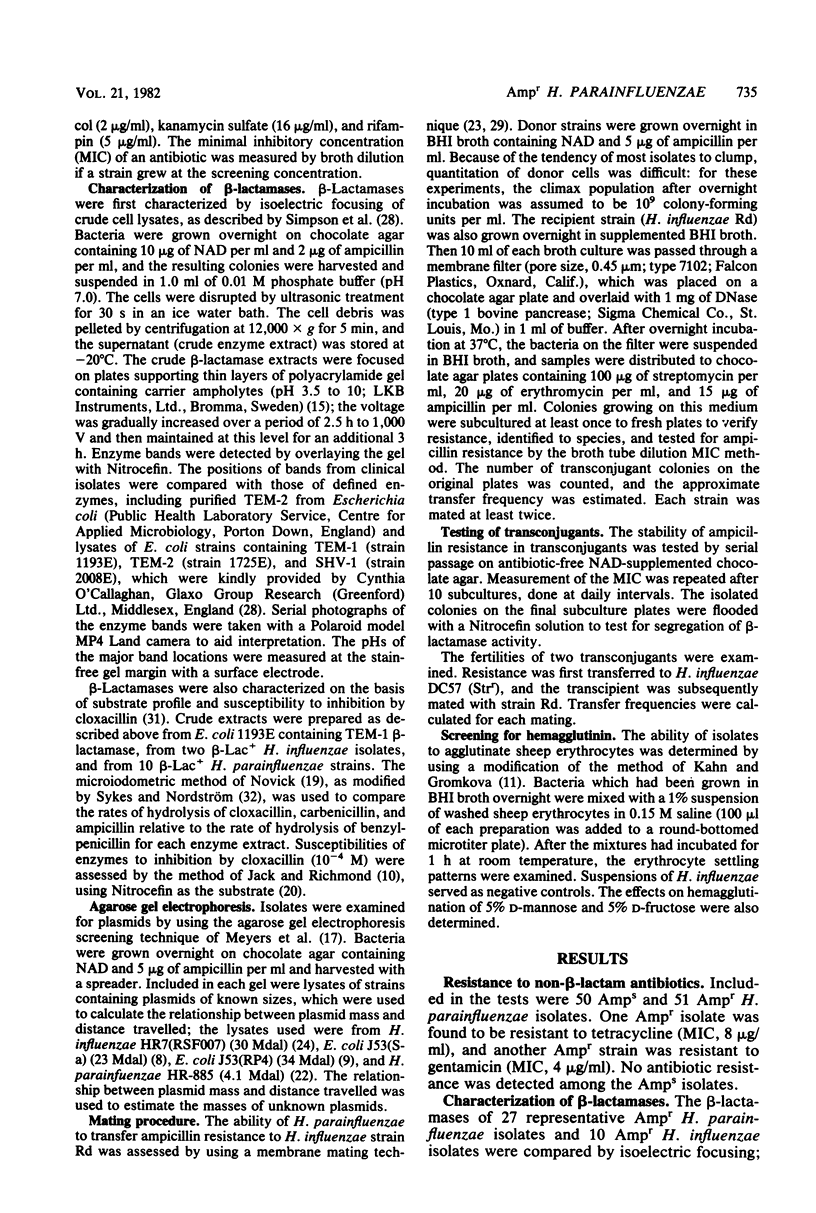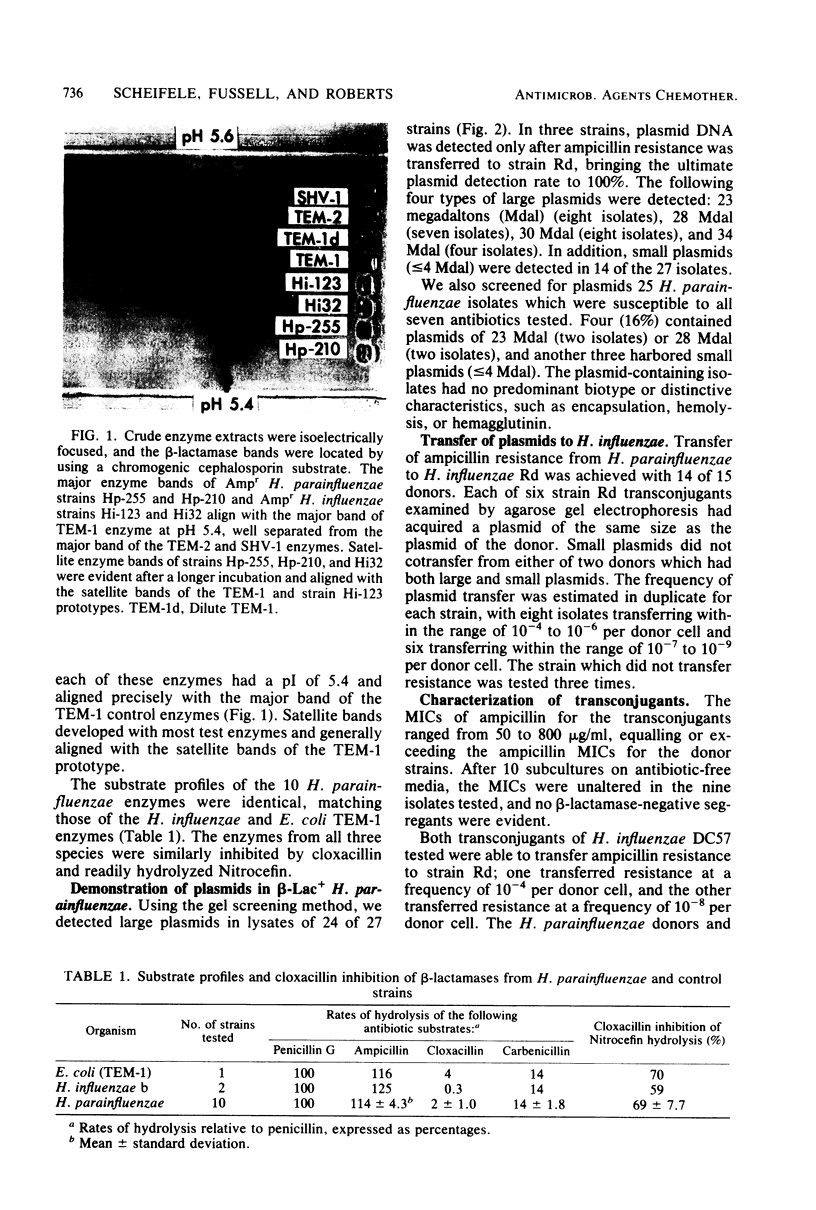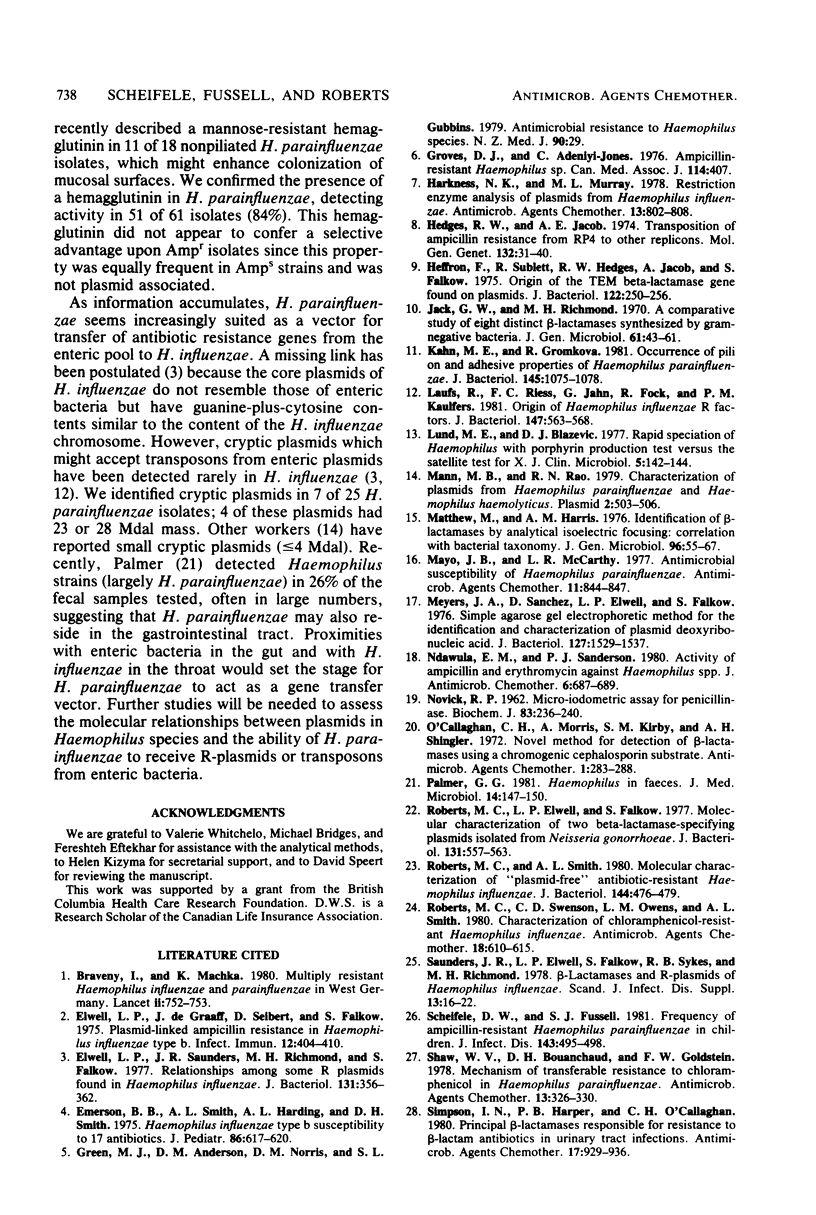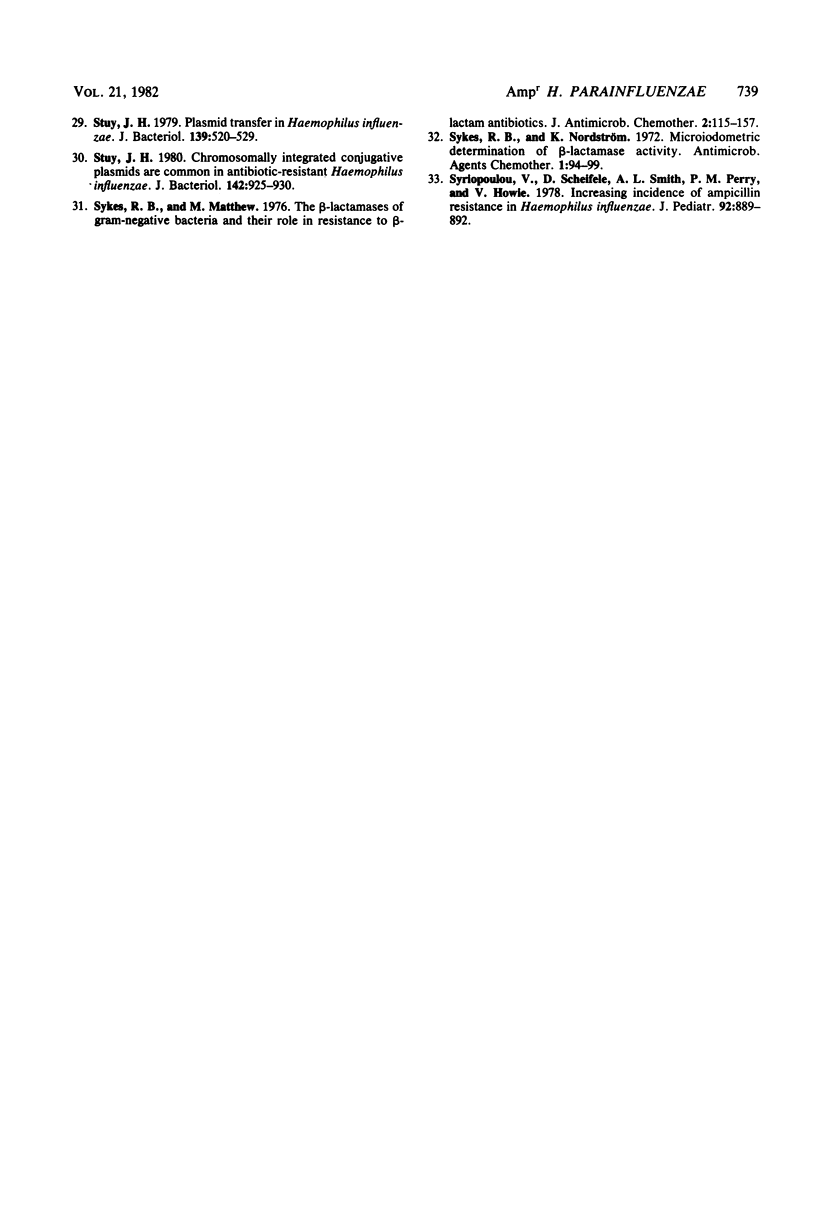Abstract
Carriage of ampicillin-resistant (Ampr) Haemophilus parainfluenzae has become frequent among children in our community, although carriage of Ampr Haemophilus influenzae remains uncommon. In this study we characterized the mechanism of ampicillin resistance in 27 representative isolates of H. parainfluenzae. As determined by isoelectric focusing, each isolate had a TEM-1 beta-lactamase; substrate profiles assessed for enzymes from 10 strains were also consistent with TEM-1 enzyme. Agarose gel electrophoresis revealed a plasmid of 23 to 34 megadaltons in each isolate and a small plasmid (less than or equal to 4 megadaltons) in 14 isolates. Transfer of ampicillin resistance to H. influenzae Rd was achieved during membrane mating with 14 of 15 donors. The transconjugants exhibited high-level ampicillin resistance (greater than or equal to 50 micrograms/ml), which was stable despite serial passage of isolates on antibiotic-free media. The transconjugants tested retained fertility. Cryptic plasmids were discovered in 7 of 25 antibiotic-susceptible H. parainfluenzae isolates. Our data suggest that H. parainfluenzae may play an important role in the exchange of Ampr genes among throat bacteria.
Full text
PDF





Images in this article
Selected References
These references are in PubMed. This may not be the complete list of references from this article.
- Braveny I., Machka K. Multiple resistant Haemophilus influenzae and parainfluenzae in West Germany. Lancet. 1980 Oct 4;2(8197):752–753. doi: 10.1016/s0140-6736(80)91980-7. [DOI] [PubMed] [Google Scholar]
- Elwell L. P., De Graaff J., Seibert D., Falkow S. Plasmid-linked ampicillin resistance in haempohilus influenza type b. Infect Immun. 1975 Aug;12(2):404–410. doi: 10.1128/iai.12.2.404-410.1975. [DOI] [PMC free article] [PubMed] [Google Scholar]
- Elwell L. P., Saunders J. R., Richmond M. H., Falkow S. Relationships among some R plasmids found in Haemophilus influenzae. J Bacteriol. 1977 Jul;131(1):356–362. doi: 10.1128/jb.131.1.356-362.1977. [DOI] [PMC free article] [PubMed] [Google Scholar]
- Emerson B. B., Smith A. L., Harding A. L., Smith D. H. Hemophilus influenzae type B susceptibility to 17 antibiotics. J Pediatr. 1975 Apr;86(4):617–620. doi: 10.1016/s0022-3476(75)80166-1. [DOI] [PubMed] [Google Scholar]
- Green M. J., Anderson D. M., Norris D. M., Gubbins S. L. Antimicrobial resistance in haemophilus species. N Z Med J. 1979 Jul 11;90(639):29–29. [PubMed] [Google Scholar]
- Groves D. J., Adeniyi-Jones C. Ampicillin-resistant Hemophilus sp. Can Med Assoc J. 1976 Mar 6;114(5):407–407. [PMC free article] [PubMed] [Google Scholar]
- Harkess N. K., Murray M. L. Restriction enzyme analysis of plasmids from Haemophilus influenzae. Antimicrob Agents Chemother. 1978 May;13(5):802–808. doi: 10.1128/aac.13.5.802. [DOI] [PMC free article] [PubMed] [Google Scholar]
- Hedges R. W., Jacob A. E. Transposition of ampicillin resistance from RP4 to other replicons. Mol Gen Genet. 1974;132(1):31–40. doi: 10.1007/BF00268228. [DOI] [PubMed] [Google Scholar]
- Heffron F., Sublett R., Hedges R. W., Jacob A., Falkow S. Origin of the TEM-beta-lactamase gene found on plasmids. J Bacteriol. 1975 Apr;122(1):250–256. doi: 10.1128/jb.122.1.250-256.1975. [DOI] [PMC free article] [PubMed] [Google Scholar]
- Jack G. W., Richmond M. H. A comparative study of eight distinct beta-lactamases synthesized by gram-negative bacteria. J Gen Microbiol. 1970 Apr;61(1):43–61. doi: 10.1099/00221287-61-1-43. [DOI] [PubMed] [Google Scholar]
- Kahn M. E., Gromkova R. Occurrence of pili on and adhesive properties of Haemophilus parainfluenzae. J Bacteriol. 1981 Feb;145(2):1075–1078. doi: 10.1128/jb.145.2.1075-1078.1981. [DOI] [PMC free article] [PubMed] [Google Scholar]
- Laufs R., Riess F. C., Jahn G., Fock R., Kaulfers P. M. Origin of Haemophilus influenzae R factors. J Bacteriol. 1981 Aug;147(2):563–568. doi: 10.1128/jb.147.2.563-568.1981. [DOI] [PMC free article] [PubMed] [Google Scholar]
- Lund M. E., Blazevic D. J. Rapid speciation of Haemophilus with the porphyrin production test versus the satellite test for X. J Clin Microbiol. 1977 Feb;5(2):142–144. doi: 10.1128/jcm.5.2.142-144.1977. [DOI] [PMC free article] [PubMed] [Google Scholar]
- Mann M. B., Nagaraja Rao R. Characterization of plasmids from Haemophilus parainfluenzae and Haemophilus haemolyticus. Plasmid. 1979 Jul;2(3):503–506. doi: 10.1016/0147-619x(79)90035-0. [DOI] [PubMed] [Google Scholar]
- Matthew M., Harris A. M. Identification of beta-lactamases by analytical isoelectric focusing: correlation with bacterial taxonomy. J Gen Microbiol. 1976 May;94(1):55–67. doi: 10.1099/00221287-94-1-55. [DOI] [PubMed] [Google Scholar]
- Mayo J. B., McCarthy L. R. Antimicrobial susceptibility of Haemophilus parainfluenzae. Antimicrob Agents Chemother. 1977 May;11(5):844–847. doi: 10.1128/aac.11.5.844. [DOI] [PMC free article] [PubMed] [Google Scholar]
- Meyers J. A., Sanchez D., Elwell L. P., Falkow S. Simple agarose gel electrophoretic method for the identification and characterization of plasmid deoxyribonucleic acid. J Bacteriol. 1976 Sep;127(3):1529–1537. doi: 10.1128/jb.127.3.1529-1537.1976. [DOI] [PMC free article] [PubMed] [Google Scholar]
- NOVICK R. P. Micro-iodometric assay for penicillinase. Biochem J. 1962 May;83:236–240. doi: 10.1042/bj0830236. [DOI] [PMC free article] [PubMed] [Google Scholar]
- Ndawula E. M., Sanderson P. J. Activity of ampicillin and erythromycin against Haemophilus spp. J Antimicrob Chemother. 1980 Sep;6(5):687–689. doi: 10.1093/jac/6.5.687. [DOI] [PubMed] [Google Scholar]
- O'Callaghan C. H., Morris A., Kirby S. M., Shingler A. H. Novel method for detection of beta-lactamases by using a chromogenic cephalosporin substrate. Antimicrob Agents Chemother. 1972 Apr;1(4):283–288. doi: 10.1128/aac.1.4.283. [DOI] [PMC free article] [PubMed] [Google Scholar]
- Palmer G. G. Haemophili in faeces. J Med Microbiol. 1981 Feb;14(1):147–150. doi: 10.1099/00222615-14-1-147. [DOI] [PubMed] [Google Scholar]
- Roberts M. C., Smith A. L. Molecular characterization of "plasmid-free" antibiotic-resistant Haemophilus influenzae. J Bacteriol. 1980 Oct;144(1):476–479. doi: 10.1128/jb.144.1.476-479.1980. [DOI] [PMC free article] [PubMed] [Google Scholar]
- Roberts M. C., Swenson C. D., Owens L. M., Smith A. L. Characterization of chloramphenicol-resistant Haemophilus influenzae. Antimicrob Agents Chemother. 1980 Oct;18(4):610–615. doi: 10.1128/aac.18.4.610. [DOI] [PMC free article] [PubMed] [Google Scholar]
- Roberts M., Elwell L. P., Falkow S. Molecular characterization of two beta-lactamase-specifying plasmids isolated from Neisseria gonorrhoeae. J Bacteriol. 1977 Aug;131(2):557–563. doi: 10.1128/jb.131.2.557-563.1977. [DOI] [PMC free article] [PubMed] [Google Scholar]
- Saunders J. R., Elwell L. P., Falkow S., Sykes R. B., Richmond M. H. beta-lactamases and R-plasmids of Haemophilus influenzae. Scand J Infect Dis Suppl. 1978;(13):16–22. [PubMed] [Google Scholar]
- Scheifele D. W., Fussell S. J. Frequency of ampicillin-resistant Haemophilus parainfluenzae in children. J Infect Dis. 1981 Mar;143(3):495–498. doi: 10.1093/infdis/143.3.495. [DOI] [PubMed] [Google Scholar]
- Shaw W. V., Bouanchaud D. H., Goldstein F. W. Mechanism of transferable resistance to chloramphenicol in Haemophilus parainfluenzae. Antimicrob Agents Chemother. 1978 Feb;13(2):326–330. doi: 10.1128/aac.13.2.326. [DOI] [PMC free article] [PubMed] [Google Scholar]
- Simpson I. N., Harper P. B., O'Callaghan C. H. Principal beta-lactamases responsible for resistance to beta-lactam antibiotics in urinary tract infections. Antimicrob Agents Chemother. 1980 Jun;17(6):929–936. doi: 10.1128/aac.17.6.929. [DOI] [PMC free article] [PubMed] [Google Scholar]
- Stuy J. H. Chromosomally integrated conjugative plasmids are common in antibiotic-resistant Haemophilus influenzae. J Bacteriol. 1980 Jun;142(3):925–930. doi: 10.1128/jb.142.3.925-930.1980. [DOI] [PMC free article] [PubMed] [Google Scholar]
- Stuy J. H. Plasmid transfer in Haemophilus influenzae. J Bacteriol. 1979 Aug;139(2):520–529. doi: 10.1128/jb.139.2.520-529.1979. [DOI] [PMC free article] [PubMed] [Google Scholar]
- Sykes R. B., Matthew M. The beta-lactamases of gram-negative bacteria and their role in resistance to beta-lactam antibiotics. J Antimicrob Chemother. 1976 Jun;2(2):115–157. doi: 10.1093/jac/2.2.115. [DOI] [PubMed] [Google Scholar]
- Sykes R. B., Nordström K. Microiodometric determination of beta-lactamase activity. Antimicrob Agents Chemother. 1972 Feb;1(2):94–99. doi: 10.1128/aac.1.2.94. [DOI] [PMC free article] [PubMed] [Google Scholar]
- Syriopoulou V., Scheifele D., Smith A. L., Perry P. M., Howie V. Increasing incidence of ampicillin resistance in Hemophilus influenzae. J Pediatr. 1978 Jun;92(6):889–892. doi: 10.1016/s0022-3476(78)80354-0. [DOI] [PubMed] [Google Scholar]




